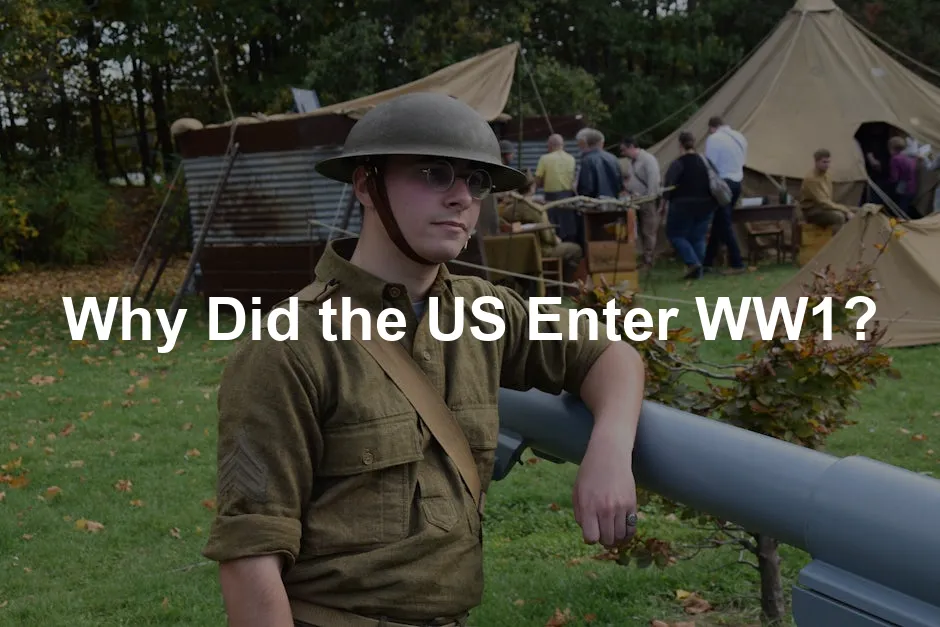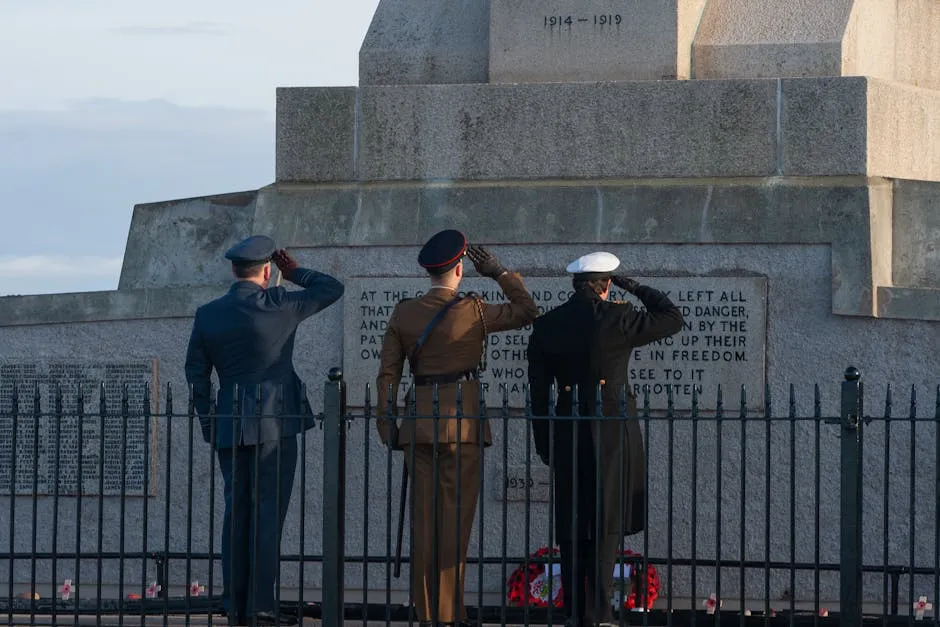
Why Did the US Enter WW1?
Introduction
World War I began in 1914, with the US initially opting for neutrality. However, public and political attitudes shifted dramatically over time. President Woodrow Wilson played a crucial role in this transformation, ultimately advocating for U.S. involvement in the conflict as tensions escalated.
If you’re looking to dive deeper into the complexities of this era, you might want to check out “The Guns of August” by Barbara W. Tuchman. This book offers a gripping narrative of the first month of World War I, detailing the events that led to a global conflict. It’s like binge-watching a historical drama, but with more facts and fewer commercials!
Summary and Overview
The U.S. maintained a neutral stance at the start of World War I, reflecting widespread isolationist sentiments. Many Americans believed the war was a European affair. However, several factors began to shift public opinion.
First, economic interests grew significantly. American banks lent vast sums to the Allies, making their victory essential for economic stability. The fear of losing these investments heightened support for intervention. Check out “A World Undone: The Story of the Great War, 1914 to 1918” by G.J. Meyer for a detailed look at how the war’s economic factors intertwined with the politics of the time.
Second, the sinking of the Lusitania in 1915 ignited anger. The loss of American lives intensified anti-German sentiment, with many calling for action against Germany. You can explore the full narrative in “Lusitania: An Epic Tragedy” by Diana Preston, which dives into the tragic events and the aftermath that changed the course of history.
Moreover, the Zimmermann Telegram inflamed tensions. This secret communication proposed a German-Mexican alliance against the U.S., shocking the American public and intensifying calls for war. If you’re curious about the intricate details of this telegram, check out “The Zimmermann Telegram” by Barbara W. Tuchman, which explores this pivotal moment in history.
President Wilson, initially hesitant, recognized the changing landscape. By early 1917, after Germany resumed unrestricted submarine warfare, Wilson sought a declaration of war. This marked a significant shift in U.S. foreign policy, aligning the nation with the Allies and against Germany.

Factors Influencing U.S. Entry into WWI
Economic Interests
Overview of American Loans to Allies
The financial stakes played a crucial role in U.S. involvement. By 1917, American banks had loaned over $2 billion to the Allies. This amount created significant economic ties between the U.S. and countries like Britain and France. If the Allies lost, these loans were at risk of default. This potential loss stirred concerns among American businesses and policymakers. As war continued, trade relations flourished with the Allies, further solidifying U.S. interests. The fear of financial collapse due to an Allied defeat swayed public and government support towards intervention, making it clear that America had a vested interest in the outcome of the war.

The Lusitania Incident
The Sinking and Its Aftermath
On May 7, 1915, the RMS Lusitania was sunk by a German U-boat, resulting in nearly 1,200 deaths, including 128 Americans. This incident sparked outrage across the United States. Many viewed the attack as a brutal violation of international law. President Wilson demanded an end to unrestricted submarine warfare. Following the sinking, anti-German sentiment surged, leading to increased calls for military action. Wilson’s Sussex pledge in 1916 temporarily calmed tensions, as Germany promised to limit attacks. However, the outrage remained. The Lusitania incident fundamentally shifted public sentiment, making the case for intervention stronger and setting the stage for America to enter the conflict.
For a detailed examination of this tragic event, consider reading “The Lusitania: The Life, Loss, and Legacy of the ‘Luxury Liner'” by John Maxtone-Graham. It’s a fascinating read that dives deep into the life of the Lusitania and its impact on the world.

Unrestricted Submarine Warfare
Germany’s Strategic Decision
In early 1917, Germany resumed unrestricted submarine warfare. This aggressive tactic targeted all ships in war zones, including neutral vessels. The decision aimed to cut off supplies to Britain and force a swift victory. However, this action escalated tensions with the U.S. Several American merchant ships were sunk, causing significant loss of life. Notably, the sinking of the Housatonic and the Vigilancia highlighted the danger to U.S. interests. Public outrage grew as these incidents were reported. President Wilson faced increasing pressure to act. Diplomatic relations with Germany were severed in February 1917. The American public rallied for intervention, igniting protests and demands for war. As tensions reached a boiling point, the U.S. could no longer maintain neutrality, pushing the nation closer to joining the conflict.

The Zimmermann Telegram
Its Contents and Significance
The Zimmermann Telegram was a secret communication sent by German Foreign Minister Arthur Zimmermann in January 1917. It proposed a military alliance with Mexico against the United States. In exchange, Germany promised to support Mexico in regaining territories lost to the U.S., including Texas, New Mexico, and Arizona. British intelligence intercepted and decrypted this message, revealing its provocative content. When the telegram was made public, it sparked outrage among Americans. The media sensationalized the news, further inflaming anti-German sentiment. This revelation significantly shifted public opinion, making many Americans more supportive of entering the war. The combination of the telegram and Germany’s renewed submarine warfare ultimately led President Wilson to seek a declaration of war against Germany in April 1917.
For those intrigued by the history and implications of the Zimmermann Telegram, consider reading “America’s Great War: World War I and the American Experience” by Edward M. Coffman. This book offers a comprehensive view of America’s role in the Great War and the factors that influenced its involvement.
The issue of territorial integrity, particularly regarding Texas, is explored in-depth in this article. why are linemen being attacked in texas
Propaganda and Public Sentiment
Shaping American Opinion
Propaganda played a significant role in garnering support for the war. The government, under President Wilson, created the Committee on Public Information (CPI) in 1917 to influence public sentiment. Key figures like George Creel led initiatives that utilized various media, including posters, films, and speeches. These campaigns painted a vivid picture of the conflict, portraying the war as a noble fight for democracy. For a closer look at the visual aspects of this propaganda, consider checking out the World War I Propaganda Posters Book, which showcases stunning visuals from that era.
Public rallies and events also fueled enthusiasm. Organizations like the American Red Cross and Liberty Loan drives encouraged citizens to contribute financially and emotionally. Major campaigns emphasized patriotism, urging Americans to enlist and support the war effort. Through these methods, propaganda transformed public opinion, turning skepticism into fervent support for U.S. involvement in World War I.

Wilson’s Call to War
The Congressional Declaration
On April 2, 1917, President Woodrow Wilson delivered a powerful address to Congress, calling for a declaration of war against Germany. He emphasized the need to make “the world safe for democracy.” Wilson pointed to Germany’s unrestricted submarine warfare and the Zimmermann Telegram, which proposed an alliance with Mexico, as key provocations. If you’re curious about the historical context of this declaration, check out “The American Red Cross: A History” by John M. McCarthy, which explores the organization’s crucial role during the war.
Congress responded swiftly; the Senate voted overwhelmingly in favor on April 4, followed by the House two days later. The declaration marked a pivotal moment in U.S. history, shifting from isolationism to active involvement. It united the American public around a common purpose, signaling a commitment to supporting the Allies in their fight against tyranny.

Conclusion
The U.S. entered World War I due to several key factors. First, the aggressive German submarine warfare threatened American ships and lives. The sinking of the Lusitania in 1915 intensified public outrage and shifted sentiment towards intervention. Second, the Zimmermann Telegram revealed Germany’s attempts to ally with Mexico, further alarming Americans. Additionally, significant economic interests tied the U.S. to the Allies’ victory, as American banks had lent substantial funds. These combined factors ultimately compelled President Wilson to seek a declaration of war, marking a pivotal shift in U.S. foreign policy and its role on the global stage.
For those looking to explore the broader implications of World War I, I highly recommend “The First World War” by John Keegan, which provides a comprehensive overview of the conflict and its lasting effects on the world.

FAQs
Why was the U.S. initially neutral in World War I?
Initially, the U.S. embraced isolationism, believing the war was a European matter. Many Americans had diverse opinions based on their heritage. German Americans and Irish Americans largely opposed involvement, while others felt a connection to the Allies. Public sentiment favored neutrality, influenced by the desire to avoid conflicts that seemed distant.
How did the sinking of the Lusitania impact U.S. entry into the war?
The Lusitania sinking in 1915 was a pivotal moment. Nearly 1,200 people died, including 128 Americans. This tragedy fueled outrage and anti-German sentiment across the U.S. President Wilson condemned the attack, demanding Germany halt unrestricted submarine warfare. The incident was a significant catalyst for shifting public opinion towards war.
What role did economic interests play in the U.S. decision to enter the war?
Economic interests were crucial in the U.S. decision to join the conflict. American banks had lent over $2 billion to the Allies. A potential Allied defeat posed a risk of financial loss for these investments. Consequently, the fear of economic repercussions contributed significantly to the growing support for intervention.
What was the Zimmermann Telegram and why was it important?
The Zimmermann Telegram was a secret communication from Germany proposing a military alliance with Mexico. Germany promised to support Mexico in reclaiming lost territories if the U.S. entered the war. When this telegram was intercepted and revealed, it incited public outrage and increased calls for war, shifting U.S. sentiment dramatically.
How did President Wilson justify the U.S. entry into World War I?
President Wilson justified U.S. entry into the war by framing it as a fight for democracy. He argued that Germany’s actions threatened not only American lives but also global stability. His famous quote about making “the world safe for democracy” resonated with many Americans and helped unify support for the war effort.
What were the consequences of U.S. entry into World War I?
The U.S. entry into the war had significant military, economic, and diplomatic consequences. American troops bolstered Allied forces, leading to critical victories. Economically, it stimulated growth in industries related to war production. Diplomatically, the U.S. emerged as a key player in shaping post-war policies and institutions.
How did American propaganda shape public opinion during WWI?
American propaganda played a vital role in shaping public opinion. The Committee on Public Information utilized posters, films, and speeches to promote the war effort. These campaigns emphasized patriotism and the moral imperative to support the Allies. They effectively transformed skepticism into enthusiastic support for U.S. involvement.
Please let us know what you think about our content by leaving a comment down below!
Thank you for reading till here 🙂
All images from Pexels




